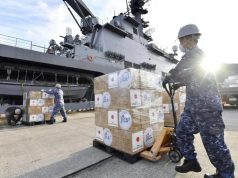
The Philippines and the United States recently commemorated the 75th anniversary of the historic landing of Gen. Douglas MacArthur in Leyte Gulf in what could considered an important event in a shared history of the two allied nations.
The Pentagon recently produced an article about the Battle of Leyte Gulf, a major naval engagement of World War II, following MacArthur’s return to the Philippines. He arrived in the gulf of Leyte in Eastern Visayas on Oct. 20, 1944.
The U.S. Embassy in the Philippines also released a video for the event.
The Philippines and the United States are #AlliesForFreedom.
On October 20, 1944, during World War II, the U.S. forces led by General Douglas MacArthur landed on Leyte, beginning the operation that would lead to the liberation of the Philippines. pic.twitter.com/W7faCICnyB
— U.S. Embassy in the Philippines (@USEmbassyPH) October 20, 2019
The Battle of Leyte Gulf was the largest naval engagement of World War II. It raged in the Philippines from Oct. 23 to 26, 1944, pitting Japan against the U.S., some Australian naval assets and some Mexican air force units. Meanwhile, a parallel land battle – in which Philippine guerrillas aided U.S
This was significant because of the battle’s pivotal role in liberating the Philippines from Japan. Historians consider the clash to be the largest naval battle in the Pacific which took place from October 23 to 26 of that year.
Last October 20 of this year, Duterte, who is known to have antipathy toward the U.S., skipped the commemoration. National Security Adviser Hermogenes Esperon attended in his stead.
National Security Adviser Secretary Hermogenes Esperon Jr. binabasa ang mensahe ni Pangulong Rodrigo Duterte sa programa ng pag alala sa ika 75 taong Anibersaryo ng Leyte Gulf Landing. pic.twitter.com/ndOFrdhgjO
— Abner Mercado (@AbnerMercado) October 20, 2019
Esperon read Duterte’s speech before officials of Japan, the United States and Australia as well as veterans of the war.
“Indeed, the blood, sweat and tears that were shed by Filipino and American troops who fought side by side to reclaim our freedom will become the cornerstone of the democratic way of life that we all enjoy today,” part of his speech read.
The event was on a Sunday, when Duterte would usually take a break in his hometown Davao. He did not attend any public event in an official capacity on that day.
Meanwhile, Yasushi Yamamoto, charge d’affaires of the Embassy of Japan, expressed condolences to the loved ones of the war victims and reiterated that Japan renounced the war for better relations with the Philippines.
“We shall not forget that the peace and prosperity we enjoy today was built upon the precious sacrifices of those who have gave their last full measure of devotion,” Yamamoto said.
World War II, which lasted from 1939 to 1945, divided countries into two great powers—the Axis (Germany, Japan and Italy) and the Allies (France, Great Britain, the United States, the Soviet Union, and China).
Liberation of the Philippines
When MacArthur arrived, two regional goals were set that would lead to the end of the war—to block Japan from acquiring resources in Southeast Asia and to recapture the Philippines.
These goals were eventually fulfilled but thousands also paid the price. Department of Defense writer David Vergun penned:
“In the end, the aims of the Battle of Leyte Gulf were achieved, but there were heavy U.S. casualties: 16,043 soldiers and 7,270 sailors were killed. The Japanese also suffered tremendous losses, with 419,912 deaths and those injured.”
This was the first time that the U.S. Navy experienced attacks from suicidal pilots called organized kamikazes.
The last Japanese commanding officer Imperial Japanese Army 2nd Lt. Hiroo Onoda surrendered to the United States in 1974.









